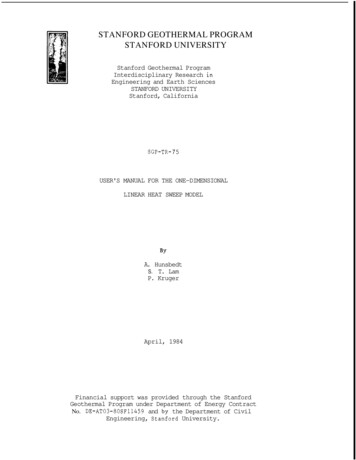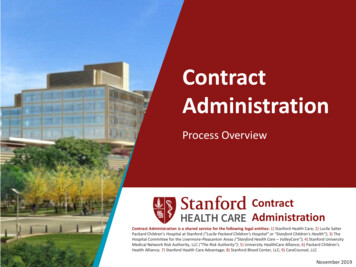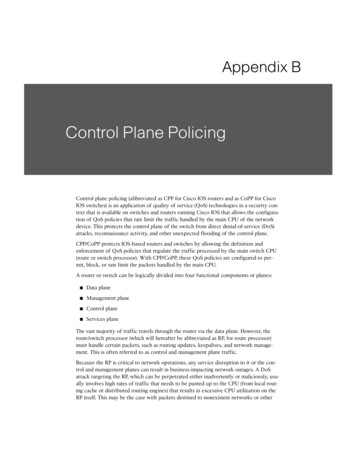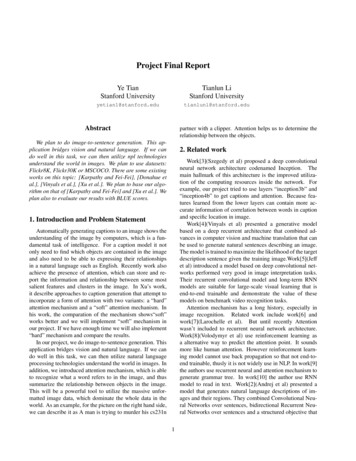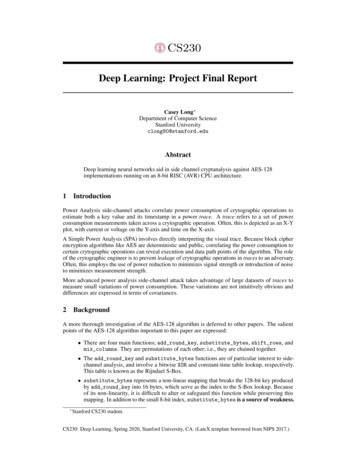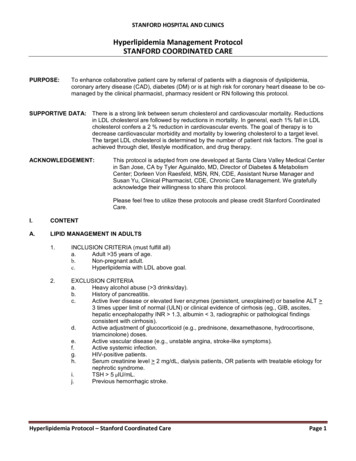
Transcription
STANFORD HOSPITAL AND CLINICSHyperlipidemia Management ProtocolSTANFORD COORDINATED CAREPURPOSE:To enhance collaborative patient care by referral of patients with a diagnosis of dyslipidemia,coronary artery disease (CAD), diabetes (DM) or is at high risk for coronary heart disease to be comanaged by the clinical pharmacist, pharmacy resident or RN following this protocol.SUPPORTIVE DATA: There is a strong link between serum cholesterol and cardiovascular mortality. Reductionsin LDL cholesterol are followed by reductions in mortality. In general, each 1% fall in LDLcholesterol confers a 2 % reduction in cardiovascular events. The goal of therapy is todecrease cardiovascular morbidity and mortality by lowering cholesterol to a target level.The target LDL cholesterol is determined by the number of patient risk factors. The goal isachieved through diet, lifestyle modification, and drug therapy.ACKNOWLEDGEMENT:This protocol is adapted from one developed at Santa Clara Valley Medical Centerin San Jose, CA by Tyler Aguinaldo, MD, Director of Diabetes & MetabolismCenter; Dorleen Von Raesfeld, MSN, RN, CDE, Assistant Nurse Manager andSusan Yu, Clinical Pharmacist, CDE, Chronic Care Management. We gratefullyacknowledge their willingness to share this protocol.Please feel free to utilize these protocols and please credit Stanford CoordinatedCare.I.CONTENTA.LIPID MANAGEMENT IN ADULTS1.INCLUSION CRITERIA (must fulfill all)a.Adult 35 years of age.b.Non-pregnant adult.c.Hyperlipidemia with LDL above goal.2.EXCLUSION CRITERIAa.Heavy alcohol abuse ( 3 drinks/day).b.History of pancreatitis.c.Active liver disease or elevated liver enzymes (persistent, unexplained) or baseline ALT 3 times upper limit of normal (ULN) or clinical evidence of cirrhosis (eg., GIB, ascites,hepatic encephalopathy INR 1.3, albumin 3, radiographic or pathological findingsconsistent with cirrhosis).d.Active adjustment of glucocorticoid (e.g., prednisone, dexamethasone, hydrocortisone,triamcinolone) doses.e.Active vascular disease (e.g., unstable angina, stroke-like symptoms).f.Active systemic infection.g.HIV-positive patients.h.Serum creatinine level 2 mg/dL, dialysis patients, OR patients with treatable etiology fornephrotic syndrome.i.TSH 5 μIU/mL.j.Previous hemorrhagic stroke.Hyperlipidemia Protocol – Stanford Coordinated CarePage 1
STANFORD HOSPITAL AND CLINICSHyperlipidemia Management ProtocolSTANFORD COORDINATED CARE3.ASSESSMENT OF LDL-C GOALa.If no history of CHD, count the number of major risk factors and estimate 10-year risk formen and women using Framingham Risk Score (see Attachment B).b.Major Risk Factors for CHD1)Cigarette smoking2)Hypertension (BP 140/90 mmHg or on antihypertensive medication)3)Low HDL ( 40 mg/dL)4)Family history of premature CHD (CHD in male first degree relative 55 yrs; CHDin female first degree relative 65 yrs)5)Age (men 45 yrs; women 55 yrs)6)Diabetes is regarded as CHD risk equivalent in ATPIIIRisk CategoryaCHD or CHD RiskbEquivalents ; High risk (10-yearrisk 20%)g2 Risk Factors ; Moderatelyhigh riskh(10-year risk 10%-20%)g2 Risk Factors ; moderate riskh(10-year risk 10%)k0-1 Risk Factor; Lower riskLDL Goal (mg/dL) 100(optional goal 70cmg/dL)i 130 130LDL level at which to initiateTherapeutic LifestyleChanges (mg/dL)d 100 130 130dLDL level at which tofconsider drug therapye 100 mg/dL ( 100mg/dl: consider drugfoptions) 130 (100-129;consider drug therapyjoptions) 160 190mg/dL(160-189: LDL-loweringdrug therapy optional)aCHD includes history of myocardial infarction, unstable angina, stable angina, coronary artery procedures(angioplasty or bypass surgery), or evidence of clinically significant myocardial ischemiabCHD risk equivalents include clinical manifestations of non-coronary forms of atherosclerotic disease, abdominalaortic aneurysm, and carotid artery disease (transient ischemic attacks or stroke of carotid origin or 50%obstruction of a carotid artery), peripheral vascular disease, diabetes, and 2 risk factors with 10-year risk for hardCHD 20%cVery high risk favors the optional LDL-C goal of 70 mg/dL. Very high-risk patients are those who have had arecent heart attack, or those who have cardiovascular disease combined with either diabetes, or severe or poorlycontrolled risk factors (such as continued smoking), or metabolic syndrome (a cluster of risk factors associated withobesity that includes high triglycerides and low HDL cholesterol).dAny person at high risk or moderately high risk who has lifestyle-related risk factors (eg, obesity, physical inactivity,elevated trigylceride, low HDL-C, or metabolic syndrome) is a candidate for therapeutic lifestyle changes to modifythese risk factors regardless of LDL-C leveleIf baseline LDL-C 100 mg/dL, institution of an LDL-lowering drug is a therapeutic option on the basis of availableclinical trial results. If a high-risk person has high triglycerides or low HDL-C, combining a fibrate or nicotinic acidwith an LDL-lowering drug can be considered.fWhen LDL-lowering drug therapy is employed, it is advised that intensity of therapy be sufficient to achieve at leasta 30% to 40% reduction in LDL-C levelsgRisk factors include cigarette smoking, hypertension (BP 140/90 mm Hg or on antihypertensive medication), lowHDL cholesterol ( 40 mg/dl), family history of premature CHD (CHD in male first-degree relative 55 years of age;CHD in female first-degree relative 65 years of age), and age (men 45 years of age, women 55 years of age) 160Hyperlipidemia Protocol – Stanford Coordinated Care 160Page 2
STANFORD HOSPITAL AND CLINICShHyperlipidemia Management ProtocolSTANFORD COORDINATED CAREElectronic 10-year calculators are available at www.nhlbi.nih.gov/guidelines/cholesterolOptional LDL-C 100 mg/dljFor moderately high-risk persons, when LDL-C level is 100-129 mg/dl, at baseline or on lifestyle therapy, initiationof an LDL-lowering drug to achieve an LDL-C level 100 mg/dl is a therapeutic option on the basis of availableclinical trial resultskAlmost all people with zero or 1 risk factor have a 10-year risk 10%, and a 10-year risk assessment in peoplewith zero or 1 risk factor is thus not necessary.IHyperlipidemia Protocol – Stanford Coordinated CarePage 3
STANFORD HOSPITAL AND CLINICSHyperlipidemia Management ProtocolSTANFORD COORDINATED CAREB.C.ASSESSMENT1.Subjectivea.Review contraindications for treatment, patient’s medical history, drug history, and druginteractions.b.Review medication list (including Rx, OTC, and herbal supplements) and dietarycompliance and adherence.c.Assess the occurrence of any adverse reactions, including symptoms of hepatotoxicity andmyopathy/ rhabdomyolysis.d.Set individualized goals for LDL.e.Medical nutrition therapy.f.Weight management.g.Physical activity.h.Access adherence/compliance.2.Objectivea.Vital signsb.Fasting lipid panel (FLP)c.BMPd.Hepatic function panele.TSHINSTRUCTIONS FOR PROTOCOLS1. Ascertain patient meets criteria for lipid protocol and determine LDL goal.A. Patients with DIABETES without known CVD:Target LDL goal 100 mg/dLB. DIABETES with known CVD:Target LDL 70 mg/dL is an option after consultation with MD.Please note other factors to consider when consulting with MD for target LDL 70mg/dL:persistent cigarette smoking, MI within past 2 years, ACS, elements of metabolic syndrome(a cluster of risk factors associated with obesity that includes high triglyceride and low HDLcholesterol), and other atherosclerotic disease (PAD, TIA, stroke of carotid origin).2.3.4.5.6.C. Patients with previous TIA or ISCHEMIC STROKE:In patients with an LDL 100 mg/dL, target a reduction of at least 50% in LDL or a LDLgoal 70 mg/dL.Obtain baseline evaluation parameters and baseline FLP, BMP, hepatic function panel, and TSHprior to initiation of therapy. Monitor necessary laboratory tests according to each protocol.Interview and evaluate patient, review goals, and reinforce lifestyle therapies at all visits.Start Protocol (see ATTACHMENT D for lipid algorithm).Address adherence to therapyTo address patient adherence to diet, exercise, and drug therapy.a.Patients should be questioned about adherence to treatment at each visit. A minimum ofthree to six months of intensive diet and exercise is recommended before medications areinitiated for primary prevention. Shorter trials of medical nutritional therapy (MNT) andexercise are appropriate for patients with severe hyperlipidemia or atheroscleroticcardiovascular disease (ASCVD), since aggressive drug therapy is of demonstratedefficacy in these high risk groups. Reasons for diet and exercise noncompliance includethe following:Hyperlipidemia Protocol – Stanford Coordinated CarePage 4
STANFORD HOSPITAL AND CLINICSHyperlipidemia Management ProtocolSTANFORD COORDINATED CARE1)2)3)4)5)Incomplete patient effort and self-motivation: Some patients are unable or unwillingto comply with strict dietary changes, such as a Step II diet, and a regular exerciseregimen.Nadir values of LDL cholesterol and triglycerides may not be achieved until afterthree to six months following lifestyle modification. Wait at least 6 to 8 weeks toretest for therapeutic lifestyle change (TLC) effect. Pharmacotherapy likewise maynot result in lower lipid values until after at least one month of treatment. Remeasurement of serum lipids after at least one month of drug therapy, or after atleast three months of dietary therapy, allows for the documentation of efficacy, theidentification of unfavorable effects of treatment, and the dose titration ofmedication.Suboptimal social support: Family and lifestyle may not be conducive to strictdietary changes. Patients may not have access to exercise facilities or safeenvironment (e.g., safe neighborhood in which to walk).Incomplete patient education: Some patients may not have received adequateinformation because of missed visits or inadequate time for counseling.Cost: Patients may perceive that dietary interventions increase costs, though thisis generally not the case. Patients unable to walk may not have access to otherexercise options (swimming, stationary bike/machines, etc.).Hyperlipidemia Protocol – Stanford Coordinated CarePage 5
STANFORD HOSPITAL AND CLINICSHyperlipidemia Management ProtocolSTANFORD COORDINATED CAREPROTOCOL A SIMVASTATIN / ATORVASTATIN THERAPYINCLUSIONSUB-CRITERIA1. Need to meet Adult Treatment Panel (ATP) III goalsADDITIONALEXCLUSIONSUB-CRITERIA1. Hypersensitivity to simvastatin and/or atorvastatin2. Caution:a. history of myopathyb. renal failure (serum creatinine level 2 mg/dL)c. significant drug interactions (see Attachment A Appendix D)ALGORITHM1. For simvastatin:a. Assess the initial dose of simvastatin.b. Usual starting dose is 20 mg at bedtime. If patient has diabetes or CHD equivalent orneeds LDL-C reduction of 45%, usual starting dose is 40 mg at bedtime.c. Measure fasting lipid panel a six to eight weeks after initiation of simvastatin.d. If the patient is not at LDL goal, double the dose of simvastatin. Confirm patient showsno sign of myopathy, liver function abnormalities, or drug-drug interaction withsimvastatin.e. Measure patient’s fasting lipid panel six to eight weeks after doubling dose ofsimvastatin.f. Continue steps c-e until the maximum dose of simvastatin (40 mg/day) is achieved.g. If the patient is not at LDL goal, stop simvastatin and may go to maximum dose ofatorvastatin (start with atorvastatin 40 mg for 1 month to verify tolerability and thenincrease to 80 mg).2. For atorvastatin:a. Assess the initial dose of atorvastatin.b. Usual starting dose is 10 mg daily. If patient has diabetes or CHD equivalent or needsLDL reduction of 45%, usual starting dose is 20 mg daily.c. Measure fasting lipid panel eight to twelve weeks after initiation of atorvastatind. If patient is not at LDL goal, double the dose of atorvastatin. Confirm patient shows nosigns of myopathy or liver function abnormalities.e. Measure patient’s fasting lipid panel eight to twelve weeks after doubling dose ofatorvastatin.f. Continue steps c-e until the maximum dose of atorvastatin (80 mg/day) is achieved.g. If the patient is not at LDL goal with atorvastatin 80 mg, consider adding second agent.h. If patient is intolerant of combination therapies, then contact MD.3. Notify MD or referring physician if any of the following:a. Unexplainable muscle weakness, tenderness, general malaise, or dark urine. ObtainCPK and notify MD of result.b. Dark urine, pale stools, RUQ abdominal pain, nausea, vomiting, yellowing of skin oreyes and/or fever. Obtain LFTs and notify MD of result.c. LFT 3 times upper limit of normal.d. Development of allergic reaction to medication.Hyperlipidemia Protocol – Stanford Coordinated CarePage 6
STANFORD HOSPITAL AND CLINICSHyperlipidemia Management ProtocolSTANFORD COORDINATED CAREGuide for Equivalency (LDL-C Reduction) Between HMG CoA Mean Percent Reductions in LDL-C (Primary Hypercholesterolemia Patients) LDL 25% LDL 25-35%Pravastatin10mgSimvastatin5mgPravastatin 20-40mgSimvastatin 1020mg LDL 35-45%Atorvastatin 1020mgPravastatin 80mgRosuvastatin 5mgSimvastatin 40mg LDL 45-50%Atorvastatin 40mgRosuvastatin 10mgSimvastatin 80mg LDL 50%Atorvastatin80mgRosuvastatin20-40 mgNote: In general, a doubling of the HMG CoA RI dose results in an additional 5-8% reduction in LDL-C levelsHyperlipidemia Protocol – Stanford Coordinated CarePage 7
STANFORD HOSPITAL AND CLINICSHyperlipidemia Management ProtocolSTANFORD COORDINATED CAREPROTOCOL B NIACIN (NIASPAN) THERAPYINCLUSIONSUB-CRITERIA1. Monotherapy: tried and failed statin (e.g. contraindication to using a statin, intolerance suchmyopathy, etc) if fulfilled inclusion criteria for RITHM1. Prior to starting niacin, baseline chemistry panel, uric acid and TSH should be measured.2. Start 500 mg PO QHS x 4 weeks, then increase 500 mg/day every 4 weeks based oneffect/tolerance. Maximum dose is 2000 mg/day3. Measure patient’s lipid panel after eight to twelve weeks of initiation or after dose adjustment.4. If patient has no contraindications to aspirin, may pre-medicate 30 minutes prior to niacindose with aspirin 325 mg.5. Notify MD if any of the following:a. Unexplainable muscle weakness or tenderness, general malaise, or dark urine. ObtainCPK and notify MD of result.b. Dark urine, pale stools, RUQ abdominal pain, nausea, vomiting, yellowing of skin oreyes and/or fever. Obtain LFTs and notify MD of result.c. LFT 2 times upper limit of normald. Development of allergic reaction to medicationD.REPORTABLE CONDITIONS / INTERVENTIONS1.2.3.4.E.Active peptic ulcer diseaseArterial bleedingGoutHypersensitivity to niacin or any componentCaution:a. concurrent anticoagulantsb. concurrent vasoactive agentsc. consumption of substantial amounts of alcohold. history of liver diseasee. predisposition to goutf. renal disease (Creatinine 2 or GFR 30)g. unstable anginah. may worsen blood glucose (monitor)i. concurrent statinsj. significant drug interactions (see Attachment B)Non-compliance for follow-up lab work or clinic/phone visits.Any adverse side effects to medications listed above.Pregnancy.Patient has reached LDL goal or maximized therapy.REFERRAL TO PHYSICIAN1.2.3.4.5.Patient is pregnant.Signs or symptoms of myopathy or CPK is 3 times upper limit of normal.Signs or symptoms of hepatotoxicity (ALT/AST 2 times upper limit of normal).LDL-C not at goal after combination therapy of two agents.Triglycerides or non-HDL-C not at goal after optimal LDL-C and lifestyle modification.Hyperlipidemia Protocol – Stanford Coordinated CarePage 8
STANFORD HOSPITAL AND CLINICSHyperlipidemia Management ProtocolSTANFORD COORDINATED CAREF.PATIENT EDUCATION / FOLLOW-UP1.2.3.4.G.Evaluation of current lab data (within last 3 months) to include: BMP, fasting lipid panel andhepatic function panel, TSH, uric acid and CPK if necessary.Identify acute or other concerns, which need to be addressed by the referring provider.Relationship among nutrition, exercise (state the need to consult with health care team beforebeginning an exercise program if there is any existing medical problems that would potentiallyprohibit such activity) and medication.Medicationsa. State the brand and amount of medication to be takenb. Describe the use and storage of medicationc. State the side effects of medicationDOCUMENTATION1. Document the following in EPIC:a.b.c.d.e.f.g.Patient goals and concernsLaboratory parameters assessment as defined in inclusion and exclusion criteriaAllergy statusEducational opportunities/reinforcement of care issues – patient education materialsavailable on EPIC (Lane Library, Up-to-date, MyHealth, etc.)Action planAny physician notification including reason and timeReferral to dieticianII.CLINICAL REQUIREMENTSA.REQUIREMENTS OF CLINICAL PHARMACIST1.EDUCATION / TRAINING:Graduated from an accredited School of Pharmacy. Currentlicensure by the California State Board of Pharmacy required andmust have either a) a PharmD degree and completion of an ASHPaccredited clinical residency program OR b) completed a Board ofPharmaceutical Specialties (BPS) Certification and have threeyears clinical experience in direct patient care. Specialty inambulatory care pharmacy preferred.The clinical pharmacist must also sign the Collaborative PracticeAgreement with the physician(s) at Stanford Coordinated Careprior to the start of practice.2.EXPERIENCE:Minimum of three years of experience as a pharmacist, withfamiliarity in chronic care management.3.INITIAL EVALUATION:In-service/orientation and competency validation to the protocol.4.ON-GOING EVALUATION:Annual review of competency.Hyperlipidemia Protocol – Stanford Coordinated CarePage 9
STANFORD HOSPITAL AND CLINICSHyperlipidemia Management ProtocolSTANFORD COORDINATED CAREB.REQUIREMENTS OF REGISTERED NURSE:1. EDUCATION / TRAINING:Current licensure in the state of California. Completion of an RNprogram from an accredited school of nursing.2. EXPERIENCE:Minimum of one year of experience as a registered nurse, withfamiliarity in disease management or chronic care management.3. INITIAL EVALUATION:In-service/orientation and competency validation to the protocol.4. ON-GOING EVALUATION:Annual review of competency.Written by:Susan Shughrue, RPh, BCACP, CDE, Ambulatory Care Clinical Pharmacist, April 2013Reviewed by:Kathan Vollrath, MD, Stanford Coordinated Care, 2013Samantha Valcourt, RN, CNS, Clinical Nurse Specialist, April 2013Approved by:Dr. Alan Glaseroff, Co-Director, Stanford Coordinated Care, April, 2013Dr. Ann Lindsay, Co-Director, Stanford Coordinated Care, April, 2013Dr. Kathan Vollrath, Stanford Coordinated Care, April, 2013Timothy Engberg, VP Stanford Ambulatory Services, May, 2013Original Date:4/2013Reviewed Dates:Revised Dates:This document is intended for use by staff of Stanford Hospital and Clinics.No representations or warranties are made for outside use.Not for outside reproduction or publication without permission.Direct inquiries to Ann Lindsay, MD 650.736.0682Stanford Coordinated CareStanford, California 94305Hyperlipidemia Protocol – Stanford Coordinated CarePage 10
ATTACHMENT AAPPENDIX AHMG CoA Reductase Inhibitor FormulationsGeneric nameBrand nameFormulation AtorvastatinLipitorFilm-coated, ellipticaltablets Zocor TabletsTabletsFilm-coated tabletsStrengths10 mg20 mg40 mg80 mg10 mg (rectangular)20 mg (rectangular)40 mg (rectangular)80 mg (oval)5 mg (round, biconvex)10 mg (round, biconvex)20 mg (round, biconvex)40 mg (oval, biconvex)5 mg (shield-shaped)10 mg (shield-shaped)20 mg (shield-shaped)40 mg (shield-shaped)80 mg ick-redBrick-redGuide for Equivalency (LDL-C Reduction) Between HMG CoA TACHMENT AAPPENDIX BMean Percent Reductions in LDL cholesterol (Primary Hypercholesterolemia Patients) LDL 25% LDL 25-35% LDL 35-45% LDL 45-50%Atorvastatin 10-20 mg Atorvastatin 40 mgPravastatin 10 mgPravastatin 20-40 mgSimvastatin 5 mgSimvastatin 10-20 mgPravastatin 80 mgRosuvastatin 10 mgSimvastatin 80 mgRosuvastatin 5 mgSimvastatin 40 mg LDL 50%Atorvastatin 80 mgRosuvastatin 20-40 mgNote: In general, a doubling of the HMG CoA Reductase Inhibitor dose results in an additional 5-8% reduction in LDL levelsMean Percent Reductions in TGs (Primary Hypercholesterolemia Patients) TG 0-5% TG 5-10% TG 10-20% TG 20-30%Atorvastatin 10-20 mgAtorvastatin 40-80 mgPravastatin 10 mgPravastatin 20-40 mgPravastatin 80 mgRosuvastatin 10-40 mgSimvastatin 80 mgRosuvastatin 5 mgSimvastatin 10-40 mgEffects of HMG CoA Reductase Inhibitors on HDL levelsAtorvastatin 10-80 mg/d, fluvastatin 20-80 mg/d, lovastatin 10-80 mg/d, pravastatin 10-80 mg/d, rosuvastatin 5-40 mg/d, simvastatin 5-80 mg/d, and Vytorin 10/40 – 10/80mg increase the HDL cholesterol level by 3-12%
ATTACHMENT AAPPENDIX CUsual Dosage and AdministrationDrug (generic name)Brand name AtorvastatinLipitor (Pfizer) PravastatinPravachol (BristolMyers-Squibb)RosuvastatinCrestor (AstraZeneca)SimvastatinZocor (Merck) FDA-Approved Daily DosageInitial: 10 mg once daily. Start 20 mg daily ifpatient has diabetes, CHD equivalent, orneeds LDL-C reduction 35%.Maximum: 80 mg once dailyInitial: 40 mg once dailyMaximum: 80 mg once daily (FDA-approvalfor 80 mg dose this year)Initial: 10 mg once dailyMaximum: 40 mg once dailyInitial: 20 mg once daily. Start 40 mg daily ifpatient has diabetes, CHD equivalent, orneeds LDL-C reduction 35%.Maximum: 80 mg once dailyTiming of doseAny time of the dayAny time of the dayAny time of the dayTake at bedtimeRecommended Doses in Patients with Impaired Renal Function and/or Taking Certain MedicationsHMG CoA ReductaseImpaired renal functionConcomitant medication/foodInhibitordosage adjustmentAtorvastatinNo dose adjustment 1g/d niacin: do not exceed 10 mg/dFibric acid derivatives: do not exceed 10 mg/dPravastatinPatients with significant renal dysfunctionshould receive an initial dose of 10 mg/d2RosuvastatinIf CrCl 30ml/min/1.73m , patients shouldCyclosporine: do not exceed 5 mg/dreceive an initial dose of5 mg/d; 10Gemfibrozil: do not exceed 10 mg/dmg once daily dose should not be exceededSimvastatinPatients with significant renal dysfunctionCyclosporine: do not exceed 10 mg/dshould receive an initial dose of 5 mg/d 1g/d niacin: do not exceed 10 mg/dFibric acid derivatives: do not exceed 10 mg/dAmiodarone: do not exceed 20 mg/dVerapamil: do not exceed 20 mg/dCPK Monitoring (per ACC/AHA/NHLBI Clinical Advisory)CK measurement should be obtained if the patient reports muscle soreness, tenderness or pain; rule out common causessuch as exercise or strenuous work and obtain a thyroid-stimulating hormone level.If the CK level is moderately elevated (3-10 times ULN), follow the patient’s symptoms and CK levels weekly until there isno longer any medical concern. Contact the primary care physician to inform him/her of the patient’s laboratoryabnormalities. Discontinue HMG CoA RI therapy if a CK level greater than 10 times ULN is seen in a patient withsuggestive muscle symptoms.
ATTACHMENT AAPPENDIX DDrug Interactions with HMG CoA Reductase InhibitorsPrecipitant drug/foodObject drugAmiodaroneLovastatin, simvastatinAtorvastatinDigoxinAzole rvastatin, romycinFibric acid derivativesGemfibrozilFenofibrate (lower incidenceof myopathy)SimvastatinAtorvastatin, lovastatin, simvastatinGrapefruit juice ( 1 qt/d)Lovastatin, simvastatinLovastatin, c acid ( 1gram/day)HMG CoA RIsProtease InhibitorsLovastatin, simvastatinRed yeast rice (Cholestin)RifampinVerapamilHMG CoA RIsFluvastatinLovastatin, simvastatinAtorvastatin, rosuvastatin,simvastatinHMG CoA RIsLovastatin, simvastatinCommentsRisk of myopathy increased. Do not exceed adose of 20 mg for simvastatin when takingamiodarone.Coadministration may increase risk for digoxintoxicity.Risk of myopathy increased. Do not takesimvastatin if the patient is on itraconazole orketoconazole.Risk of myopathy increased. Do not exceed adose of 5 mg and 10 mg, rosuvastatin andsimvastatin, respectively, when takingcyclosporine.Do not exceed a dose of simvastatin 10mgCoadministration increases the risk ofmyopathy/rhabdomyolysis.Avoid simvastatin/lovastatin.Coadministration increases the risk ofmyopathy/rhabdomyolysis.Do not exceed doses of 10 mg, 10 mg, 10 mg& 20 mg for rosuvastatin, simvastatin,atorvastatin and lovastatin, respectively.Do not take simvastatin if the patient consumes 1 quart of grapefruit juice/day.Increased prothrombin time may occur with coadministration.Risk of myopathy increased. Do not takesimvastatin or lovastatin if the patient is onnefazodone.Coadministration increases the risk ofmyopathy/rhabdomyolysis.Do not exceed simvastatin 10 mg, atorvastatin10 mg, or lovastatin 20 mg.Do not take simvastatin or lovastatin if the patientis taking a protease inhibitor.Red yeast rice contains HMG CoA RIsRifampin may decrease fluvastatin efficacy.Risk of myopathy increased. Do not exceed adose of 20 mg for simvastatin or 40 mg forlovastatin when taking verapamil.Bolded drugs should not be co-administered or exceed maximum dose with the drugs in the adjacent column(contraindication/warning).
ATTACHMENT BNicotinic Acid FormulationsGeneric nameBrand nameNicotinic Acid (alsoNiacinavailable as genericproducts)Niacin extendedreleaseNiaspanFormulationTablets TabletsUsual Dosage and AdministrationDrug (generic name)Brand nameNicotinic AcidNiacin (various)Niacin extendedreleaseStrengths50 mg100 mg250 mg500 mg500 mg750 mg1000 mgFDA-Approved Daily DosageInitial: 100 mg daily to BID; increase by100 mg BID-TID per weekMaximum: 6 grams/dInitial: 500 mg HS; increase by 500 mg every4 weeksMaximum: 2 grams/d Niaspan (KOS)ColorwhiteOff-whiteOff-whiteOff-whiteTiming of doseWith mealsAt bedtime along with alight snackRecommended Doses in Patients with Impaired Renal Function and/or Taking Certain MedicationsNicotinic AcidImpaired renal functionConcomitant medication/fooddosage adjustmentNiacinAlcohol may increase side effects of flushing andpruritus and should be avoided. NiaspanNo dose adjustment; caution inAlcohol or hot drinks may increase side effects ofpatients with renal disease.flushing and pruritus and should be avoided around thetime of ingestion.Frequency of Liver Function Test MonitoringNicotinic AcidWhen to perform LFTNiacinPerform LFTs prior to initiating therapy andstevery 6 to 12 weeks for the 1 year;periodically (about every 6 months) thereafter. NiaspanPerform LFTs prior to initiating therapy andstevery 6 to 12 weeks for the 1 year;periodically (about every 6 months) thereafter.Drug Interactions with Nicotinic AcidPrecipitant drug/foodObject drugHMG CoA RIsNicotinic acid ( 1gram/day)BASAntihypertensive agents Niaspan NiaspanCommentsIf the LFTs are elevated, perform a second LFT toconfirm the abnormality. Notify MD or referring physicianif LFTs 2 X ULN.Same as above.CommentsCoadministration increases the risk of myopathy/rhabdomyolysis.Do not exceed simvastatin 10 mg, lovastatin 20 mg, oratorvastatin 10 mg dailyTake Niaspan 1 hour before or 4 hours after BAS.Niacin may potentiate the effects of ganglionic blocking agentsand vasoactive drugs resulting in postural hypotension.Bolded drugs should not be co-administered or exceed maximum dose with the drugs in the adjacent column(contraindication/warning)
ATTACHMENT CFramingham Point ScoresEstimated 10-Year Percentage Risk of Coronary Heart Disease. (W women, M men)AGEPoints -79-9-4036810111213Points (W)HDL (mg/dL)-7-3036810121416 6050-5940-49 40Points (M)Points (W)-1012-1012SYSTOLIC BLOOD PRESSURE (mmHg)T points if untreatedUT points if untreatedBP 120120-129130-139140-159 159UT (M)00112UT (W)01234T (M)01223T (W)03456POINTS FOR INDICATED AGE GROUPSSmoking statusNonsmoker (M)Smoker (M)Nonsmoker (W)Smoker (W)Total Cholesterol (mg/dL)Men 160160-199200-239240-279 280Women 160160-199200-239240-279 22ESTIMATED 10-YEAR PERCENTAGE RISK OF CHDMenTotal Points 000-45-678910111213141516 17% Risk 1112345681012162025 30WomenTotal Points 99-1213-1415161718192021222324 25% Risk 112345681114172227 30
Lifestyle modification (LM) for 8-12 weeks. Proceed directly todrug therapy for CHD or CHD-equivalent patients or previous TIA or ischemic strokeStartFasting LipidPanel (within3 months)Work with carecoordinator to orderlipid panelNOEndYESDid pt fail orcannot toleratestatins?YESStart NiacinNOEndStart atorvastatinYESYESLDL at goal?NODiscuss with PCPDid pt fail orcannot toleratesimvastatin?FLP 8-12 weeksLDL at goal?YESMaximizeatorvastatin doseFLP 6-8 weeeksNONOLDL at goal?YESEndNOStart simvastatinLDL at goal?NOYESEndTitrate to maximum dose perprotocol or maximal tolerateddose LMEndFLP 6-8 weeksMaximize atorvastatindose lifestylemodificationFLP 8-12 weeksLDL at goal?YESFLP 6-8 weeksSwitch toatorvastatinLDL at goal?YESEndLDL at goal?NODiscuss with PCPNONOYESEndMaximizesimvastatin dose lifestylemodificationFLP 6-8 weeksLDL at goal?YESNODiscuss withPCPEnd
STANFORD HOSPITAL AND CLINICS Hyperlipidemia Management Protocol STANFORD COORDINATED CARE Hyperlipidemia Protocol - Stanford Coordinated Care Page 2 3. ASSESSMENT OF LDL-C GOAL a. If no history of CHD, count the number of major risk factors and estimate 10-year risk for men and women using Framingham Risk Score (see Attachment B). b.
